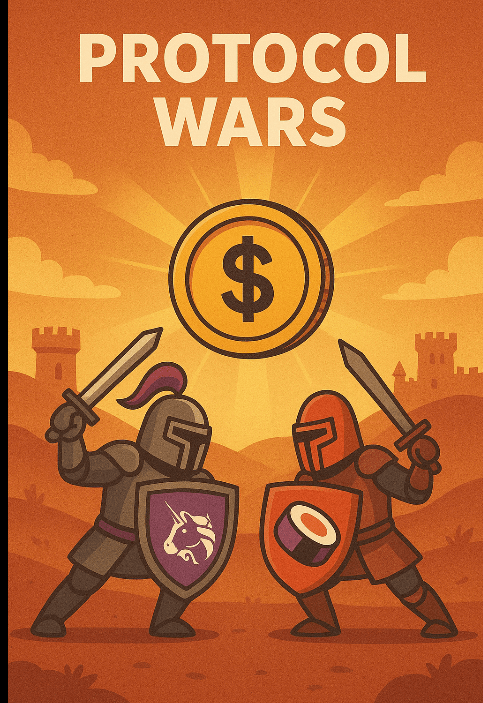In the world of crypto 🌐, wars are not fought with swords 🗡️ or cannons 🏰, but with codes 💻, incentives 💰, and innovations to attract liquidity 🌊.
Here, each protocol is like a digital kingdom 👑, with an army of developers 🛠️, a treasury of liquidity 💎, and a weapon of financial incentives 📈.
Why are these wars taking place? 🤔
The answer is simple: liquidity is the blood 🩸 that flows through the veins of any financial network. Whoever has liquidity has the ability to execute transactions quickly ⚡, attract users 👥, and increase the market value of their tokens 🪙.
Examples of protocol wars 🥊
1. The battle of Uniswap 🦄 and SushiSwap 🍣 (2020)
At that time, Uniswap was the undisputed queen of decentralized trading (DEX) 👑, but SushiSwap emerged with a bold plan ⚔️:
It offered users additional incentives 💰 if they moved their liquidity from Uniswap to it.
The plan succeeded, and "liquidity was pulled" 🩸 (Liquidity Migration) within a few days, in what was called a "vampire attack" 🧛♂️.
This incident has become a classic example 📚 of using incentives to win the war 💥.
2. Curve 🔄 and Balancer ⚖️
In the market for liquidity platforms dedicated to stablecoins 💵, Curve and Balancer compete through advanced algorithmic designs 🧮 and extremely low fees ⬇️.
Each protocol strives to prove it is the most efficient 🥇, and the most deserving to be the primary destination for stablecoin liquidity 🌊.
3. Layer 1 Wars 🏛️
Ethereum 🦄 leads, but Solana 🚀, Avalanche ❄️, and Cardano ♾️ entered the battle by offering faster ⚡ transactions and lower fees 💲.
This war is not just on the technology level 🛠️, but also on attracting developers 👩💻 and building a strong community 💪 around each network.
Warfare tactics in crypto 🧠
1. Vampire Attacks 🧛♂️: Pulling liquidity from a competing protocol through massive incentives 💰.
2. Liquidity Mining 🌾: Granting free tokens 🪙 to those who provide liquidity.
3. Integration with major applications 🔗: Gaining user loyalty through partnerships.
4. Improving user experience 🎯: Sometimes the easiest network to use wins, even if it is not the cheapest 💵 or the fastest ⚡.
Why is it important for us to understand these wars? 🧐
Because the investor 💼 or user 👥 who monitors these battles can anticipate market trends 🔮 and discover opportunities before they become apparent to everyone.
Understanding the dynamics of competition helps us distinguish between the protocol that wins a temporary "battle" ⏳ and the one that builds a long-term "empire" 🏰.



